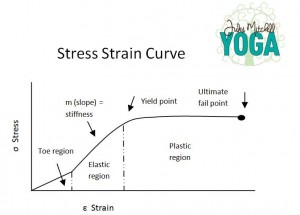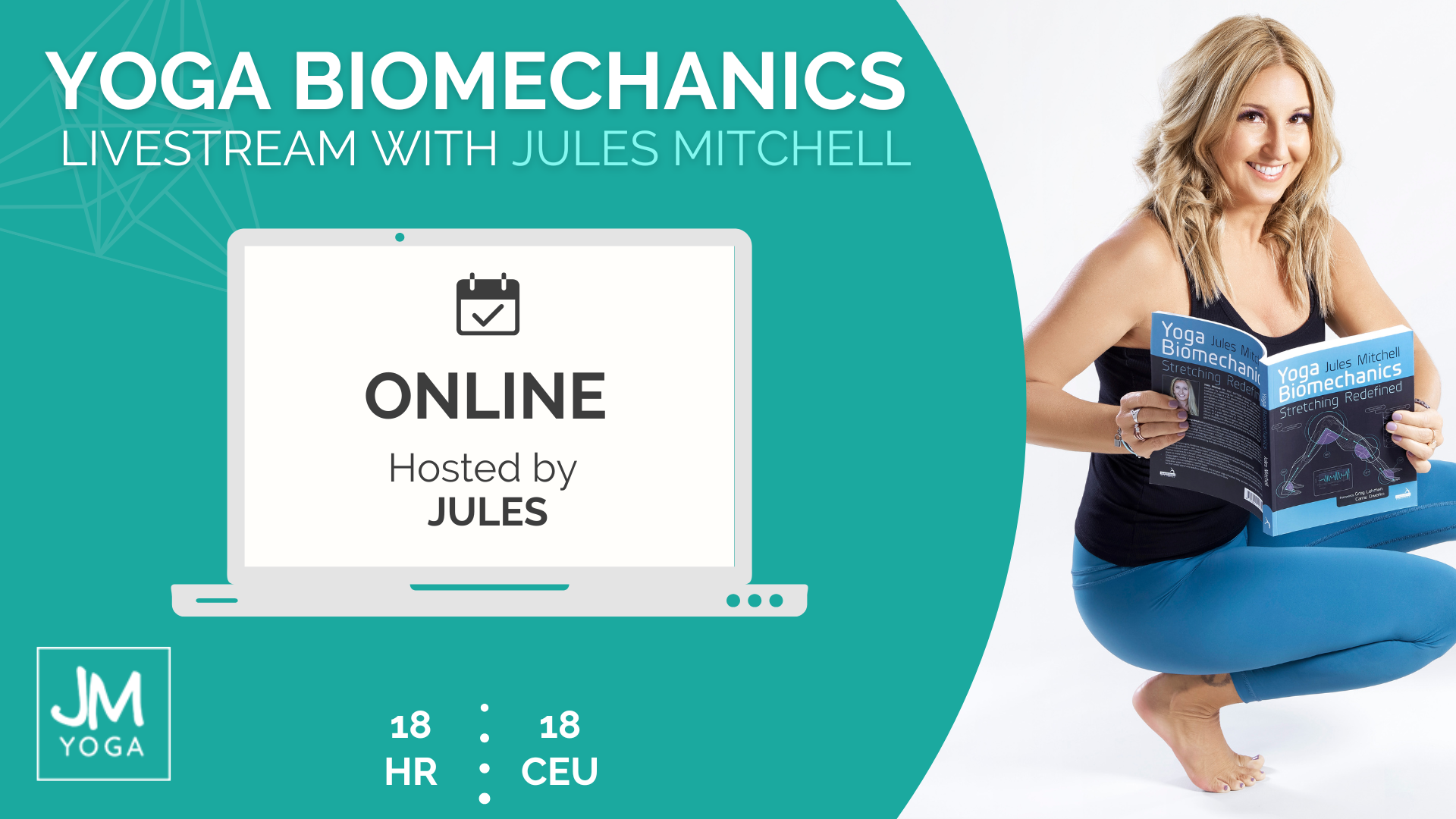If you read my first post on the topic of biomechanical stiffness, you may remember this statement:
The problem is that when we use stiffness in a casual manner, it doesn’t match up with the mechanical definition of stiffness. This causes confusion and we end up thinking that the opposite of stiffness is flexibility (defined four our purposes as increased range of motion – ROM). It’s not. The opposite is more like compliance.
Stiff tissues resist deformation. You can have stiff connective tissue and still have normal range of motion (flexibility). Stiff really just means strong and resilient. A more thorough definition, also from my first post on stiffness:
In mechanical terms, stiffness is a measure of how much load a material (steel, for example) can take before it deforms. In biomechanical terms, stiffness is a measure of how much load a tissue (tendon, for example) can take before it deforms. Essentially, stiffness represents how strong and resilient a material is under stress.
Mechanical stiffness is the slope of the curve in the stress strain curve below, up until the yield point. Mechanical stiffness is not the same as unyielding. A tissue with high mechanical stiffness will still yield, but the amount of applied load it can withstand while remaining within the elastic (safe) region is greater. Or said another way, the greater the mechanical stiffness, the greater the load bearing capacity.
An example always helps.
Let’s consider the ankle region. Without getting into the complex anatomy of the foot and ankle, we can all agree that we have many ligamentous structures and other connective tissue materials holding these bones together. If you go hiking (just as an example of some uneven terrain) greater stiffness will help you avoid injury. How so? When your ankle is under a load (your body mass and gravity) it will only maintain its structural integrity to the degree of stiffness that it has. If your ankle ligaments don’t have enough stiffness, they will deform – and potentially deform beyond their elastic capacity or yield point. Read: tissue damage, injury.
This doesn’t mean you don’t have joint mobility. You can have full range of motion in your ankle joints and still have a lot of stiffness. Furthermore, stiffness can be increased through training, even low-load resistance training.¹ So reducing stiffness does not give you more flexibility (greater range of motion). Reducing stiffness only gets you less load bearing capacity. And who wants that?
Have you ever said, or heard someone say, “Oh, my hamstrings are so stiff, I need to stretch them out.” Consider what that actually means. Your connective tissues (which surround and are continuous with the proteins that make up what we call hamstrings) are supposed to be stiff!
If you are “feeling stiff” as in “your body aches” it means something different. I probably just means you need to move and open some joint angles that have been closed for too long.
Or perhaps your muscles are unyielding. In that case, a stretching protocol would serve you well as long as you targeted the tissue of mechanism causing the unyielding. But not in an attempt to reduce or eliminate mechanical stiffness!
Our connective tissues – tendons, ligaments, and fascia; they all have stiffness. It’s an unavoidable property that we should not try to do away with by stretching, massaging, or hot tubbing. You cannot do away with stiffness.
Joint materials that lack sufficient stiffness are known to be lax.² Joint laxity should not be confused with flexibility either. Joint laxity is more a matter of an inability to regulate range of motion due to, wait for it…
…insufficient stiffness!
This where compliance becomes a factor. More on that and range later. Right now, I’m going to go work on my stiffness.
Hey! Maybe we could get Fergie to change her lyrics to “I be up in the gym, just workin’ on my stiffness.”
Sorry, I couldn’t resist.
_______________________________________________________
1 Kubo, K., Kanehisa, H., Miyatani, M., Tachi, M., & Fukunaga, T. (2003). Effect of low-load resistance training on the tendon properties in middle-aged and elderly women. Acta Physiologica Scandinavica, 178(1), 25–32. doi:10.1046/j.1365-201X.2003.01097.x
2 Kovaleski, J. E., Heitman, R. J., Gurchiek, L. R., Hollis, J. M., Liu, W., & Pearsall, A. W. (2014). Joint Stability Characteristics of the Ankle Complex in Female Athletes With Histories of Lateral Ankle Sprain, Part II: Clinical Experience Using Arthrometric Measurement. Journal of Athletic Training, 49(2). doi:10.4085/1062-6050-49.2.08
Extend Your Learning: Online Education With Jules
Yoga Biomechanics Livestream
My flagship 3-day livestream course is for teachers who have an insatiable curiosity about human movement and kinesiology, are eager to know what the research says about yoga, and are open to accepting that alignment rules aren’t always accurate. Includes 30 days of access to the livestream replay and slides. 18 CEUs. Learn more >



Hey Jules,
I understand your description of needing “stiffness” to maintain integrity and function. I wonder if the semantics are confusing. Shirley Sahrmann, PT PhD has some pretty intriguing research speaking to relative stiffness in the body causing movement dysfunction. “Stiffness is defined as the change in tension per unit change of length. Stiffness for our purposes refers to the amount of resistance present during the passive elongation of the muscle and connective tissue and comparing that with any compensatory movements that may occur.
Over 50 years of clinical testing, Sahrmann found the number of people with actual tight muscles was much less than the number of people who had a “relative stiffness” or flexibility problem. An Example: Control of the lumbar spine during knee flexion when in prone.
If the lumbar spine supporting musculature is more flexible in relation to a stiff rectus femoris, then when the knee is passively flexed, the lumbar spine may move into extension, as the stiff rectus femoris pulls on the flexible lumbar spine muscles.
If one repeats this exercise with the abdominals engaged to stabilize the lumbar spine and knee flexion range of motion is still the same, then one needs to work on increasing the stiffness and stability of the abdominal muscles.
So I guess I disagree with the comment that we don’t need to address stiffness, because it is all relative. Does that make sense? Thoughts?
.
Hi Chrys!
First off, thanks for the comment.
It is exactly an issue of semantics. I’m talking about mechanical stiffness, which is represented by the slope of the stress strain curve. A mechanically stiff tissue can still yield. The more mechanical stiffness of a tissue, the more strength it has. I posted a few citations as reference to see how mechanical stiffness is measured. However, you can be very flexible (full joint ROM) and still have strong (mechanically stiff tissues). As I mentioned, I will write more about that in a future post.
From your comment, “Stiffness is defined as the change in tension per unit change of length.” – Agreed. But as soon is it goes into “stiffness for our purposes” it suggests some use of the word other than the mechanical definition – thereby making it difficult to comment on.
However, “If one repeats this exercise with the abdominals engaged to stabilize the lumbar spine and knee flexion range of motion is still the same, then one needs to work
on increasing the stiffness and stability of the abdominal muscles.” It sounds like she is talking about muscle activation, which is not the same as mechanical stiffness of collagen.
“So I guess I disagree with the comment that we don’t need to address stiffness, because it is all relative.” Did I say we don’t need to address stiffness? I hope I didn’t!!
I think stiffness should totally be addressed, both my increasing muscle tension (as in isometrics) and by progressive external loading (as in eccentric training).
Or if by addressing stiffness, you mean reducing stiffness in the rectus femoris muscle (in your example above), then I would inquire into what is causing the limited joint ROM. Do we know it’s mechanical stiffness of the collagen? It sounds like she is talking about passive muscle tissue stiffness (which is not at all the same as mechanical stiffness) and therefore could be related to joint dysfunction, muscle length, fibrosis, neural input, etc? Again, I’d have to read the study to fully understand. But from the excerpt above, it sounds more like unyielding (sometimes called passive stiffness) than mechanical stiffness.
As my friend and respected colleague, please let me know if I have clarified.
Love love love, Jules
Hi Jules! Thanks so much for this great clarification of what stiffness means in a mechanical context. It’s super helpful! I find the distinction between “flexibility” (which occurs WITH stiffness) and “lax joints” (which occur with insufficient stiffness) really interesting, especially in the realm of yoga poses. Can’t wait to learn more about this from you! 🙂